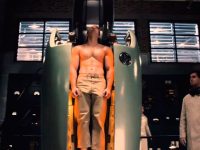
Illustration: Anna Sanchis
For the ancient Greeks, the natural order emanated from an epic creation based on a fight. This is explained in Hesiod’s Theogony (seventh century BC) with the triumph of Zeus over the chaos of the original Titans. Conversely, the Mazdayasna preached by the Persian Prophet Zoroaster or Zarathustra (tenth century BC) argued that the eternal and supreme god Ahura Mazda lovingly created all creatures. That is, a kind creation based on divine generosity. Judaism, and then Christianity, drank from this doctrine, this much is clear. Our original myth, therefore, is more Zoroastrian than Hesiodic.
That explains Stanley Kubrick’s success by appealing to the symphonic poem by Richard Strauss Thus spoke Zarathustra (1896) as the background music to open his film 2001: A space odyssey (1968). This auditive start accompanying the sequence of a primate throwing a bone into the air as a first tool, thus starting the Anthropocene, became iconic. Half a century later, 2001 came and went and we have not reached the future imagined by the film yet, with the uprising of HAL, but artificial intelligence has made great progress, and we can somewhat move through the Solar System. Kubrick’s was a great science-fiction movie.
Science fiction is a very interesting genre, though often distorted. It was born in the nineteenth century with works that are already classics, like Frankenstein (1818) by Mary Shelley, some of Jules Verne’s novels or Strange case of Dr. Jeckyll and Mr. Hyde (1886) by Robert L. Stevenson. In 1938, a radio broadcast by Orson Welles about a supposed Martian invasion of the Earth – adaptating Herbert G. Wells’s novel The War of the Worlds (1898) – caused panic in the United States and led to a series of films about aliens. The scientific soundness of these products was weak or non-existent, but they achieved great popularity. Epistemologically speaking, it stands out that they exhibit much more romantic fantasy than scientific imagination. Rather than scientifically stimulating situations or innovative technology solutions, they often include literary delusions about already known techno-scientific realities. In Richard Fleischer’s film Fantastic voyage (1966), a discreet film adaptation of the novel by Isaac Asimov, some humans reduced to microscopic size circulate through the bloodstream of a person, but they do mathematical operations like cavemen, without a hint of the already incipient computing science of the time. Strictly speaking, all these fantasies are not science fiction, but pseudo-scientific fiction.
«We do not know what the science of future will bring, but we can assess the resilience of past unscientific concepts»
It is also noteworthy that these products find it difficult to move in a diachronic context. When faced with very advanced grotesque – and surprisingly anthropomorphic – aliens, they exhibit «modern» technology that, half a century later, makes us burst into laughter. They assume their present is the climax of history and are not aware of their inevitable immediate obsolescence. Because, from our present, it is hard to imagine «other» presents and, even more, our own future. This is why science fiction is more convincing when it does not leave synchrony and creates, for example, Frankenstein monsters or Mr. Hydes to be the nemeses of Doctor Jekylls. However, Dr. Frankenstein’s metallurgical electricity or the almost alchemical pharmacopoeia of Dr. Jekyll in their now century-old laboratories cause more laughter than admiration.
We do not know what the science of future will bring, but we can assess the resilience of past unscientific concepts. Half a century after Kubrick’s futuristic metaphor, the mythical creation of Zarathustra survives and continues to be the cosmogonic core for some. It is baffling: that does indeed seem science fiction…





